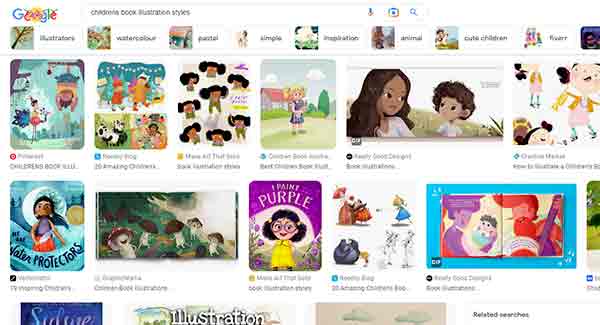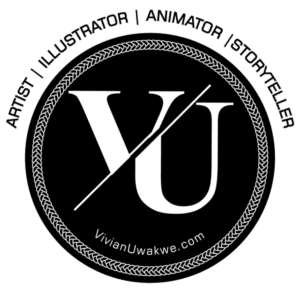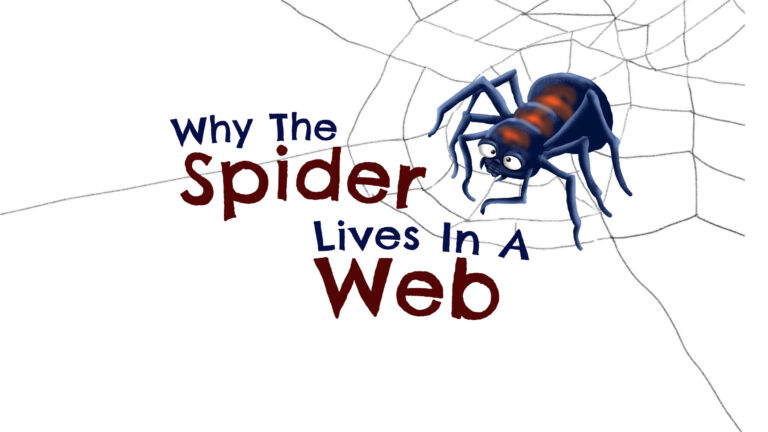A children’s book illustrator is responsible for creating the visual elements of a picture book, including the characters, settings, and any other graphics or images. The illustrator works closely with the author to ensure that the illustrations accurately depict the story and enhance the overall reading experience.

If you need to hire an illustrator to create illustrations for a children’s book, it is best not to go out on a limb without equipping yourself with the knowledge to do so. The process of hiring an illustrator for a children’s book may appear easy but can quickly become a daunting task especially if you are new to children’s book publishing. Having worked with several clients over the years, let me draw from my experience and give you a personal guide on how to hire a children’s book illustrator.
First, Make Sure Your Book Has Been Written And Edited

Before ever engaging the services of an illustrator, ensure not only that you have completed your children’s book but that your editor has also finished editing your book. This piece of advice is almost never given to new authors and it is a top priority.
If you do not heed this advice, you will likely make your illustrator create more illustrations than needed because after your book manuscript is completed and edited, changes in your storyline might require you to modify any already completed illustrations or create completely new ones based on the edited story.
Either way, you will pay more than your initial budget and spend more time on your project. This means that taking our time to finish your story is without a doubt, the best way to go.
It is important to note that if you aren’t self-publishing and a publishing house is handling your manuscript, they will use their own illustrator. You will not need to hire and illustrate your own books. That said, however, many traditionally published authors eventually take the self-publishing route and publish their own books so the information in this guide is invaluable to every children’s book writer regardless of which publishing route they take.
Second, Split Your Manuscript Into Pages
Once your manuscript is completed, start splitting the text into the pages you desire. You can do this in any word, text or even excel sheet you desire and if you work manually, using paper will do.
Just imagine it was a book and you were flipping through the pages. What text would you want to see on a single page or a double spread? Keep going until you reach the end of the story.
By the time you are done with this step, you will have an idea of the number of pages your book will be. There is something you might want to factor in at this stage. Print pages usually come in multiples of four. This means that they might be 24, 28, 32, 36 etc but they can’t be 22, 27, 33, 39.
When you finish splitting the pages of your book and it does not end in a multiple of the number four, for example, 25 pages, you will need to creatively see how you can adjust your pages so that either the pages stop at 24 or they increase and end at 28.
Third, Prepare An Illustrator Brief
Once you have finished ascertaining the number of pages your book will have is it now time to describe the illustration you want on each page. Do this from the first page to the last. This is your illustration brief. It is the most important document you need when discussing with your illustrator.
Many experienced authors and publishers do not hand over the full manuscript to their illustrator. They simply just hand over the brief. Working with your illustrator brief automatically keeps your manuscript confidential.
If you do not want your story to get into the wrong hands, you can use only your brief when working with your illustrator. Your illustrator might be honest ad have the best of intentions but imagine what would happen if their computer was hacked and someone with ulterior motives got unauthorised access to your manuscript. I bet you would truly wish you gave them a brief instead of your original manuscript.
One way some authors get around this is to create a dummy copy of their book and sketch (however poorly even with stick figures), what they want on the page with notes to describe more details. From the second step, you already know how many pages your book will have. If you have a 24-page book, fold twelve sheets of paper in half and staple them in the middle. Then proceed to create a dummy copy of your book.
Put your own creativity into action. Imagine each page as you want and describe what you want to be drawn on it. When you are done, scan each page of your dummy copy so you can send it to your illustrator.
Fourth, Create A Simple Character Sheet
Now that you have an illustration brief, it is time to create a simple character sheet for your book. A character sheet is a very useful document that itemises all the characters in your storybook (usually by their name), describes their key physical features/ characteristics, plus any other relevant details that will help your illustrator to create your vision of the character.
Go through your illustration brief page by page and draw up a list of every single character on each page. Write their names on your character sheet and describe their physical features.
For example, if your main character is a boy called Charlie, you can name him and say:
- Charlie – Boy between 4-5 years old, caucasian, curly blond hair, freckles, rosy cheeks, smiley face, Stripped t-shirt and red shorts.
- Susan – Girl between 2-3 years old, African American, puffy ponytails, chubby cheeks, curious look, yellow cute dress, and so on.
You can enhance your character sheet by searching the internet for characters that somewhat resemble the characters in your book and saving their photos so that you can send them off to your designer later
Having a character sheet is not compulsory as most illustrators can work with the brief only but you do not want to appear like a rookie when you are discussing with an illustrator. Providing extra supporting documents as a character sheet will not only make your illustrator take you more seriously, it will additionally get you the best value for your money because it provides extra charity to enable your illustrator to capture your vision.
Fifth, Research The Type Of Illustrations You Want & The Size Of Your Book
Now that your illustration brief and your character sheet are done, it is time to choose the illustration style you want your book designed in.
Every author has a certain specification for the illustrations in the storybook they want to publish. And if you do not have an extensive vocabulary to describe what you want to your illustrator, the best way is to find visual representations that closely resemble your preferences and there are two ways I recommend you do this.
The first way is online but you might get lost in the pool of billions of images and artist websites on the internet so this is what you can do. Go to Google Images and type phrases like:
- “Illustration styles”
- “children’s book Illustration styles”
- “childrens Illustration styles”
- “kidlit illustration”
The screenshots below show samples of what you may typically get.

Scroll through and save photos of any style that interests you. Now move on to Amazon and go to the children’s books section. Once there, you can browse through the pool of books by age or by categories and select a few that appeal to you. Screenshot their covers and use Amazon’s “Look Inside” feature to scroll through their inner pages and screenshot any illustration or layout you like. These photos will save you tons of work when you deal with your illustrator.
The second way you can figure out the illustration style you want for your book is the good old-fashioned way of going to a library or local bookstore nearest to you. You will see tons of books in the children’s book section.
A visit to a library or bookstore also helps you physically get a feel of the dimensions/size you might eventually want your book to be. Two very popular children’s book sizes are 6 x 9 inches, 8.5 x 8.5 inches and 8.5 x 11 inches. The 8.5 x 8.5 inches is my personal favourite because I like the square shape.
If prior to this, you haven’t been looking around at illustrator portfolios, now might be a good time. Most of the books you have been looking at have the name of their illustrators displayed right on the front cover. It might be worth taking down those names and checking them on social media (particularly Instagram and Twitter) because you are going to need them at the seventh stage of your journey.
When you are done with this part of your research, you now move to the next step.
Sixth, Decide Your Budget
At this point, it is time to think about how much you want to spend on your illustration. Budgeting for a children’s book illustrator can be a complex process, as there are many factors to consider. Having a clear idea of your budget before you start the process of hiring an illustrator helps you find someone who fits your needs and your budget.
When it comes to illustration, if you pay peanuts, you get monkeys. I can’t think of any other service where this is more true. However, knowing how much you can afford to pay an illustrator will help you narrow down your options and find the best illustrator for your budget.
Different illustrators have different styles, and this can affect the price of their services. The more detailed an illustration is, the higher the price you will likely pay for it. The style of illustrations you want for your book will affect how much it will cost to hire an illustrator with that style.
Also, more experienced illustrators may charge more for their services than less experienced illustrators. Consider the experience level of the illustrator you are considering hiring and how that fits into your budget.
Because you did your previous homework of creating your illustrator brief and character sheet, you already know the number of illustrations you will need in your book. The more illustrations you need for your book, the more it will cost to hire an illustrator. Consider how many illustrations you will need and how much you can afford to pay for each one.
Lastly, set a lower and an upper range for your budget to a specific figure. For example, do not set a budget of maybe $3,000. Instead, set a budget for $1,800 – $3,500. Start your negotiations with your lower budget whilst bearing in mind how far up you might go if your preferred illustrator demands higher pay.
With all these one, you are now ready to move to the next step and hire an illustrator.
Seventh, Hire An Illustrator
This is the moment you have been waiting for. It is now time to actually hire an illustrator. Remember that during your research for illustration styles, I asked you to make a list of the illustrators for the books you researched, now is the time to look at their portfolios online and also that of artists similar to them.
Many illustrators can be found on social media sites like Instagram, Facebook and LinkedIn. Sites like Behance and Dribble are professionally designed for creatives and also have elaborate illustrator portfolios. You can also go to freelancing sites like Upwork or LinkedIn and check for professional illustrators. Fiverr is also a great platform but could be a bit tricky. To successfully select a good illustrator, you must take their rating into account and if they have a Fiverr Pro-Verified status, it might be a good indicator of their professional abilities.
Some illustrator and children’s author groups on Facebook are also great places to ask for recommendations. I suggest you use illustrators that have worked with authors in the group and not just random picks unless they have an online footprint that is genuine.
Sometimes, an illustrator may be able to work in a variety of styles so if you like their work but want them to create illustrations in a style separate from the one they did, send them a sample of your preferred style and ask if they’ll be able to work in that style.
It is also worth noting at this point that your illustrator might not be a graphic artist. They may create your illustrations but you may need to hire a graphic artist to place the text in different positions on your pages and format your book for publishing. Occasionally, you might meet an illustrator who can render both services but it is good to ask this question upfront and know that if they cannot, you will need to hire a graphic designer once your first set of illustrations are ready.
You can narrow them down to a list of three. Contact each one, to know if they are available for work and if they are, hand them your illustrator brief to get a feel of the scope of your work then negotiate with the illustrator but be fair in your offer.
If negotiations go well, start by giving them your character sheet and asking them to create about two samples of your main character. You will need to pay a token for this service. It will help you know the capability of your illustrator as well as give you the opportunity to discontinue and engage another illustrator who might meet your requirements.
If you are satisfied with the character sketch, then it is time to arrange a payment schedule and start your project.
Eight Step, Creating The Payment Schedule And Project Timeline
Discuss payment mode and project length before you formally engage the services of your illustrator. Work out a payment schedule with your illustrator.
Let’s take an example. If you agree that the total project cost is $2,400 and you have 12 illustrations in total which will take your illustrator 3 months to complete, then you can split your expectations into monthly deliverables. Your illustrator will deliver approximately 4 illustrations per month and you pay once they are delivered.
If you are hiring your illustrator via a freelancing site like Upwork, Fiver, Freelancer.com etc, setting project timelines and payment schedules is quite easy and automated. The project funds are moved to an escrow account and once you approve a completed timeline, payment is released to the illustrator.
You should also factor in how many revisions will be permitted for every completed illustration and the cost for each. If you take time to provide enough details in your illustration brief and character sheet, major requests for modifications can be completely avoided and save you costs.
The expected deliverables should be discussed as well. You are going to need not just the output files but the source files as well. Some popular file formats are JPEG and PDF and the resolution must be a minimum of 300 dpi or above to enhance print quality. In addition to this, it is advised you collect the source files so that in future, you can still hire another person to modify your artwork if your original illustrator is unavailable.
When all these are agreed upon, it is time to draw up a contract between you and your illustrator. The contract between you and your chosen illustrator should specify the names and contact information of both parties, describe the scope of work that the illustrator will carry out and include any specific requirements or deliverables. The contract should also explicitly specify how much the illustrator will be paid, and when payment will be made by you.
Also very important, the contract should clearly specify who will own the copyright to the illustrations and how the illustrations may be used. Under copyright law, the creator of a work is generally the initial owner of the copyright hence the person with the exclusive right to control the use of the illustration. However, copyright ownership can be transferred through a contract or other written agreement.
One option is to draw up a work-for-hire illustrator contract, which is a contract in which the illustrator is hired to create a specific piece of work and the copyright to that work is owned by the hiring party. Some illustrators might not opt for this but others do not mind.
The bottom line is that without a written agreement, and almost always, some amount of reasonable compensation, the illustrator will retain copyright ownership.
Finally, the contract should specify under what circumstances the contract between you and the illustrator can be terminated and how any outstanding obligations will be handled in the event of termination.
It is also good practice to include clauses addressing confidentiality, indemnification, and governing law and have a lawyer review a contract before both of you sign it.
Some illustrators already have their contracts. If for some reason, you agree to adopt theirs, have a lawyer review the terms and conditions before you sign it.
Ninth Step, Monitor Your Project Till It Ends
When contracts have been signed and your illustrator starts the work, it is not time to relax. You have to take on the responsibility of monitoring your project till it is completed.
Don’t overwhelm the illustrator with incessant emails or calls instead, use the specific milestones set in the contract as check-in points to know when to contact the illustrator and ensure that the project is on track. This helps you ascertain if they are making progress and meeting the deadlines specified in the contract.
A responsible illustrator will be consistent in submitting expected deliverables when due and if they are unable to will give early notice with a new expected delivery date which is usually a couple of days afterwards.
If however your illustrator is habitually missing submission deadlines, but their work quality is good, maybe the project timeline needs to be adjusted and your delivery expectations lowered. Where you may need to exploit your work contract is
If you have any concerns about the progress of the project, it is important to address them promptly with the illustrator. No one envisages serious problems in any illustration project and many of these problems can be resolved if you do your homework right before hiring an illustrator and your contract is tight.
We however live in a complex world and there might be the odd occurrence where serious unresolvable issues might mean that you can no longer work with the illustrator you hired or vice versa. I have had an instance where I felt exploited by a client who continually requested an insane amount of modifications to every single illustration I created for them to the point where it drove me insane and I was glad to end the contract.
Illustrators usually have pre-booked calendars and other projects lined up so when a client keeps requesting modifications, it can cause them to up their fees and put a strain on their relationship with the client altogether. A request to change the colour of the outfit a character is wearing from red to green is a considerate request. However, a request to change a character from a Persian cat to a sphynx cat is a major overhaul so your illustrator will need to renegotiate the contractual terms and agreed fees with you.
If an illustration project reaches a breaking limit, it might be better to call it off and hire a new illustrator. To end an illustration contract, you should follow the termination provisions outlined in the contract. This may include giving written notice of your intent to terminate the contract, or following a specific process for termination outlined in the contract. You should also make sure to fulfil any outstanding obligations under the contract before it is terminated.
Tenth Step, Maintain A Relationship With Your Illustrator
Even a smooth-sailing project will come to an end and you will need to formally end the project. Ensure that you have made all outstanding payments and collected all your files plus source files. Ask the illustrator any questions you have in mind.
I advise you to end on a good note and leave lines of communication open with your illustrator. You can never predict when you will need a document or some information from them even long after your book has been published. I have clients still contacting me years after I concluded their projects.
If you are in publishing for the long haul, and your illustrator did an excellent job for you, ensure you maintain contact with them. Finding a good illustrator is not an easy task so if you do find one, keep them close.
I remember an extreme situation where a woman on a Facebook forum for authors and illustrators expressed her pain about the sudden passing of an illustrator who had worked on several of her books. Her loss was compounded by knowing how hard it would be to find a new illustrator. She was very grateful for the opportunity to have maintained that relationship with that illustrator over the years.
Maintaining your relationship with your illustrator can lead to better communication and collaboration on future projects, which can ultimately result in higher-quality work. Good relationships can also lead to a more efficient working process, as both of you are more familiar with each other’s needs and preferences.
Additionally, it can make it easier to negotiate any future contractual terms and resolve any issues that may arise during a project overall making it easier for you both to work together on future projects.
Conclusion
A beautifully illustrated children’s picture book can make your children’s book stand out in the millions of books available for children all over the world. This also propels you into the limelight in the highly competitive world of children’s book publishing. There are many children’s books that do not have exceptional stories but are flying off bookshelves simply because they have great illustrations.
You should not take the task of hiring an illustrator for your children’s book very seriously. Once your manuscript is completed and edited, prepare your illustrator brief and a simple character sheet. Research and determine the type of art style you want for your book and make a budget for illustration. Now hire the illustrator and monitor your project till it is completed and you have all your illustrations. Then you can go on with your publishing process.
Overall, hiring an illustrator for a children’s book requires clear communication and a willingness to collaborate so as to bring out your vision as an author and capture the attention of your intended audience.
With this guide, even without any experience, you can effectively hire an illustrator and achieve your publishing goals.




